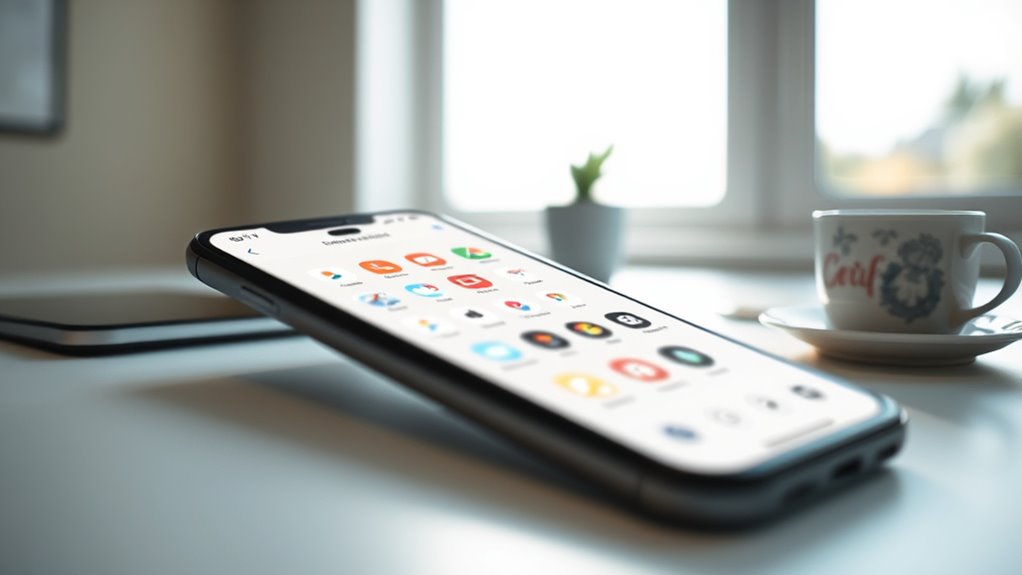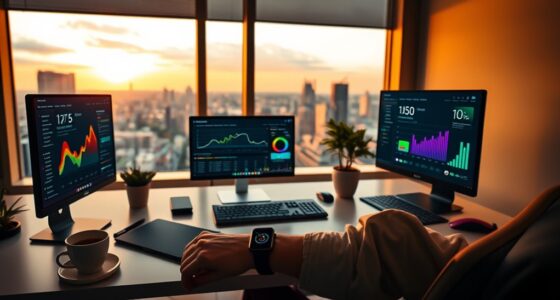To declutter your apps and reclaim focus, start by recognizing your digital habits through tracking screen time and app usage. Remove apps that don’t add value, organize your home screens, and limit notifications. Set intentional device-check times and use tools to monitor your habits. Embracing digital minimalism helps you reduce distractions and boosts productivity. If you keep exploring, you’ll discover effective strategies to create a purposeful digital environment that supports your well-being.
Key Takeaways
- Identify and delete apps that don’t align with your goals or add value to reduce digital clutter.
- Organize home screens with folders and secondary pages to minimize distractions and streamline access.
- Limit notifications to only essential alerts, preventing unnecessary interruptions and mental clutter.
- Set specific times for device use to foster intentional engagement and reduce mindless scrolling.
- Track your screen time to understand habits and adjust app usage for improved focus and productivity.

Have you ever felt overwhelmed by the constant barrage of notifications, apps, and digital distractions? It’s easy to get caught in a cycle where your screen time spirals out of control, leaving you drained and unfocused. That’s where digital minimalism comes in, helping you declutter your digital life and regain control over your attention. The first step is recognizing how much time you spend on your devices. Tracking your screen time reveals just how much of your day is consumed by apps, social media, and notifications. Once you see the numbers, it becomes clear that reducing your screen time isn’t just about limiting device use; it’s about reclaiming your mental clarity and emotional well-being.
Recognize your device habits to reclaim focus and improve well-being.
A digital detox can be a powerful way to reset your habits. It involves intentionally unplugging for a set period—whether a few hours, a day, or even longer—to break free from the constant noise. During this time, you focus on activities that don’t involve screens, like reading, walking, or connecting with loved ones face-to-face. A digital detox helps reset your relationship with technology, making you more conscious of how often you reach for your device and what prompts you to do so. It’s not about abandoning technology altogether but about creating boundaries that serve your well-being. Incorporating app usage management can further support your efforts by helping you monitor and limit your digital habits. Additionally, understanding the importance of digital asset diversification can encourage you to explore non-digital activities that enrich your life beyond screens.
To make your digital minimalism sustainable, start by decluttering your apps. Delete the ones that don’t add value or contribute to your goals. Keep only the essential apps that genuinely serve your needs or bring you joy. Organize your home screen to minimize distractions—place important apps in folders or on secondary pages, so they’re not front and center. Limiting notifications is another vital step; disable alerts that aren’t urgent or necessary. This reduces the constant interruptions that fragment your focus and chip away at your productivity. Recognizing the importance of managing your digital environment aligns with the concept of understanding your app usage.
Implementing these changes can considerably lower your screen time, but it requires intentional effort. Set specific times during the day when you check your devices, and stick to them. Use tools and apps that monitor your usage, helping you stay accountable. Over time, you’ll find that you don’t need to constantly check your phone or be glued to your screen. Instead, you’ll have more space for meaningful activities and genuine interactions. Digital minimalism isn’t about avoiding technology; it’s about making it work for you, not against you. By decluttering your apps and embracing a digital detox, you take the first steps toward a more focused, intentional life. Recognizing how color accuracy influences the quality of your viewing experience can also help you set better expectations for your digital landscape.
Frequently Asked Questions
How Do I Start Practicing Digital Minimalism Effectively?
To start practicing digital minimalism effectively, you should begin with a digital detox by disconnecting from non-essential apps and notifications. Set specific times for mindful browsing, focusing only on what truly matters. Create boundaries around your device use, like designated phone-free periods. Gradually, you’ll reclaim your focus, reduce distractions, and develop healthier digital habits. Consistency is key—over time, these small changes will make a big difference in your overall well-being.
What Tools Can Help Me Declutter My Digital Life?
Your digital life can feel like an overwhelming jungle, but tools like app blockers and usage trackers are your trusty machete. Use app blockers to prevent yourself from wasting time on distracting apps, and usage trackers to identify and cut back on overuse. These tools make it easier to reclaim focus, cut clutter, and enjoy a more intentional digital experience. Start today, and watch your productivity soar!
How Often Should I Review My App Usage?
You should review your app usage weekly to stay aware of your screen time and prevent app fatigue. Regular check-ins help you identify apps that waste your time or cause distraction. By tracking your screen time, you can make adjustments, deleting or limiting apps that don’t serve your goals. Consistent reviews guarantee your digital habits support your focus and well-being, keeping your device use intentional and balanced.
Can Digital Minimalism Improve Mental Health?
Imagine your mind as a garden, and screen addiction as weeds choking out your peace. Yes, digital minimalism can improve your mental health by helping you cultivate clarity and calm. A digital detox resets your focus, reducing anxiety caused by constant notifications. When you declutter your apps, you create space for meaningful moments, nurturing your well-being and transforming your digital landscape into a peaceful oasis instead of a chaotic jungle.
Is Digital Minimalism Suitable for Children and Teenagers?
You might wonder if digital minimalism suits children and teenagers. It’s beneficial because it helps limit excessive screen time and promotes healthier habits. Using parental controls, you can set boundaries and encourage mindful app use. By teaching kids to declutter their digital lives, you empower them to focus better, reduce distractions, and develop a balanced relationship with technology, ensuring they grow up with healthier tech habits.
Conclusion
Just like Thoreau sought simplicity in Walden, you can find clarity by decluttering your digital life. When you pare down your apps and notifications, you create space for what truly matters—whether it’s deep focus, genuine connection, or peaceful moments. Remember, the digital world is a tool, not a trap. Embrace minimalism and reclaim your attention, so you can live more intentionally—just as the greatest minds have shown us the value of simplicity amidst chaos.










